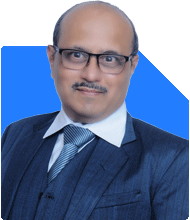Ramalingam Kalirajan |10893 Answers |Ask -Follow
Mutual Funds, Financial Planning Expert - Answered on Jul 14, 2024
He has an MBA in finance from the University of Madras and is a certified financial planner.
He is the director and chief financial planner at Holistic Investment, a Chennai-based firm that offers financial planning and wealth management advice.... more

I am 39 years old male and i am only person earning . I am married and my wife is also looking for work and we have 2 kids . I do have many parents dependent on me. My annual income 30 lac and I have two personal loans with emi of 28000 and 47000 as well four credit card with a liability of 5lac. We are currently have 2 bhk flat and a plot in bangalore . I do have investments in kotak mutual funds and lic mutual funds around 50 lac. My concern i want to come out of the debt and create corpus fund . Plan for my retirement at 60
Your monthly EMIs are significant, with Rs. 28,000 and Rs. 47,000 for personal loans. Additionally, you have a credit card liability of Rs. 5 lakhs. Your primary concern is to manage and eliminate your debts while creating a corpus for retirement and other financial goals.
Tackling High-Interest Debt
Your first priority should be to address high-interest debts, especially credit card debt. These can quickly escalate and create financial strain.
Debt Consolidation: Consider consolidating your credit card debts. This can help you get a lower interest rate, reducing the overall cost of your debt.
Prioritize Payments: Focus on paying off the highest interest debt first. This will save you money in the long run.
Limit Credit Card Usage: Try to avoid using credit cards unless absolutely necessary. Pay off the balance in full each month to avoid interest charges.
Managing Personal Loans
Your personal loan EMIs are quite substantial. To ease this burden:
Refinance Loans: Look into refinancing options to get a lower interest rate. This can reduce your monthly EMIs.
Prepayment: If possible, use any surplus income or bonuses to make prepayments. This will reduce the principal amount and the interest burden.
Loan Tenure Adjustment: Extending the loan tenure can reduce the monthly EMI, although it may increase the overall interest paid.
Building a Robust Emergency Fund
An emergency fund is crucial to avoid falling into debt during unforeseen circumstances. Aim to build an emergency fund that covers 6-12 months of living expenses.
Automate Savings: Set up an automatic transfer to a high-interest savings account every month. This ensures consistency in building your emergency fund.
Accessible but Separate: Keep this fund in a separate account from your regular savings to avoid the temptation to dip into it.
Investment Strategy Review
You have significant investments in mutual funds. Let's refine your strategy to ensure it aligns with your goals.
Evaluate Mutual Funds: Review the performance of your Kotak and LIC mutual funds. Ensure they align with your risk tolerance and financial goals.
Diversification: Diversify your investments across different asset classes to mitigate risk. This could include equity, debt, and gold.
Professional Advice: Regularly consult with a Certified Financial Planner to review and adjust your investment strategy as needed.
Retirement Planning
With the aim to retire at 60, you need a well-structured plan.
Calculate Corpus Required: Estimate the amount you need for retirement considering inflation and lifestyle.
Regular Investments: Continue investing regularly in mutual funds. Use a mix of equity and debt to balance growth and stability.
Increase Contributions: As your income grows or debts reduce, increase your contributions towards retirement savings.
Planning for Children's Future
Your children’s education and future expenses need strategic planning.
Education Fund: Start a dedicated education fund for your children. Use child-specific mutual funds or fixed deposits to ensure growth and safety.
Regular Contributions: Allocate a specific amount monthly towards this fund. The earlier you start, the larger the corpus will be due to compounding.
Managing Dependents
Supporting multiple dependents can be challenging. Ensure their financial security without compromising your own goals.
Health Insurance: Ensure all dependents are covered under a comprehensive health insurance policy. This reduces the risk of out-of-pocket medical expenses.
Budgeting: Create a strict budget to manage monthly expenses efficiently. Identify areas where you can cut costs without affecting the quality of life.
Creating Additional Income Streams
Explore ways to increase your income to ease financial stress and meet goals faster.
Wife’s Employment: Support your wife in her job search. Her income can significantly contribute to household finances.
Side Gigs: Consider freelance or part-time work. Leveraging your skills can create additional income streams.
Long-term Investment Approach
For a sustainable financial future, adopt a long-term investment approach.
SIP (Systematic Investment Plan): Continue investing in SIPs for mutual funds. This ensures disciplined investment and benefits from rupee cost averaging.
Review and Rebalance: Periodically review your portfolio. Rebalance it based on performance and changing financial goals.
Avoiding Common Pitfalls
Emotional Investing: Avoid making investment decisions based on market emotions. Stick to your plan and consult your Certified Financial Planner.
High-risk Investments: Stay away from high-risk, high-reward schemes. They can jeopardize your financial stability.
Benefits of Regular Funds
While considering investments, understand the benefits of regular funds over direct funds.
Expert Guidance: Investing through a Mutual Fund Distributor (MFD) with CFP credentials provides professional guidance.
Continuous Support: Regular funds come with advisory support for portfolio management, which can be crucial for making informed decisions.
Long-term Relationship: Building a relationship with a certified planner ensures personalized advice aligned with your changing financial goals.
Final Insights
Your financial journey requires a strategic approach to manage debt and build wealth. Address high-interest debts first and focus on creating an emergency fund. Regularly review and diversify investments with professional guidance. Plan meticulously for retirement and children's future while managing dependents efficiently. Explore additional income streams to ease financial burden. Stick to a long-term investment strategy and avoid common pitfalls. Embrace the benefits of regular funds for professional advice and continuous support.
By following these steps, you can achieve financial stability and meet your goals. Always consult a Certified Financial Planner for personalized advice and stay committed to your financial plan.
Best Regards,
K. Ramalingam, MBA, CFP,
Chief Financial Planner,
www.holisticinvestment.in
You may like to see similar questions and answers below
Ramalingam Kalirajan |10893 Answers |Ask -Follow
Mutual Funds, Financial Planning Expert - Answered on Jun 25, 2024
Milind Vadjikar | Answer |Ask -Follow
Insurance, Stocks, MF, PF Expert - Answered on Nov 27, 2024
Ramalingam Kalirajan |10893 Answers |Ask -Follow
Mutual Funds, Financial Planning Expert - Answered on Jun 04, 2025
Ramalingam Kalirajan |10893 Answers |Ask -Follow
Mutual Funds, Financial Planning Expert - Answered on Jun 21, 2025
Reetika Sharma |425 Answers |Ask -Follow
Financial Planner, MF and Insurance Expert - Answered on Oct 07, 2025
Nitin Narkhede |113 Answers |Ask -Follow
MF, PF Expert - Answered on Dec 15, 2025
Nitin Narkhede |113 Answers |Ask -Follow
MF, PF Expert - Answered on Dec 15, 2025
Ramalingam Kalirajan |10893 Answers |Ask -Follow
Mutual Funds, Financial Planning Expert - Answered on Dec 15, 2025
Ramalingam Kalirajan |10893 Answers |Ask -Follow
Mutual Funds, Financial Planning Expert - Answered on Dec 15, 2025
Radheshyam Zanwar |6746 Answers |Ask -Follow
MHT-CET, IIT-JEE, NEET-UG Expert - Answered on Dec 15, 2025
Ramalingam Kalirajan |10893 Answers |Ask -Follow
Mutual Funds, Financial Planning Expert - Answered on Dec 15, 2025
Ramalingam Kalirajan |10893 Answers |Ask -Follow
Mutual Funds, Financial Planning Expert - Answered on Dec 15, 2025
Ramalingam Kalirajan |10893 Answers |Ask -Follow
Mutual Funds, Financial Planning Expert - Answered on Dec 15, 2025
Samraat Jadhav |2508 Answers |Ask -Follow
Stock Market Expert - Answered on Dec 15, 2025
Ramalingam Kalirajan |10893 Answers |Ask -Follow
Mutual Funds, Financial Planning Expert - Answered on Dec 15, 2025

























